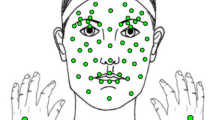Abstract
Three experiments were designed to assess whether the perception of interpersonal emotions induced by animated geometric figures, such as those used by Heider and Simmel (1944) and Michotte (1950), vary consensually among observers according to the specific kinetic stimuli presented. Using Michotte's original disk method, the first experiment showed eight kinetic structures to 60 subjects who were asked to describe their perceptions on rating scales. The perceptions were shown to vary according to the dynamic features of the stimulus, and a high degree of interobserver consensus was generally recorded. In the second experiment, subjects were shown human silhouettes animated according to the same kinetic structures as those of experiment 1. The profiles of their answers were generally similar to those recorded for animated geometric figures, but the consensus tended to be weaker. The third experiment compared the rating scale descriptions of five kinetic structures made by European, American, and African subjects tested in their own countries. The perceptions of European and American subjects were very close to each other for the larger part of the material. The data of the Africans differed from the Americans in one way and from the Europeans in another way.
Similar content being viewed by others
References
Averill, J. R. (1980). On the paucity of positive emotions. In K. R. Blankstein, P. Pliner, & J. Polivy (Eds.),Assessment and modification of emotional behavior. New York: Plenum Press.
Bassili, J. N. (1976). Temporal and spatial contingencies in the perception of social events.Journal of Personality and Social Psychology, 33 680–685.
Bassili, J. N. (1978). Facial motion in the perception of faces and of emotional expression.Journal of Experimental Psychology, 4(3), 373–379.
Bassili, J. N. (1979). Emotional recognition: The role of facial movement and the relative importance of upper and lower areas of the face.Journal of Personality and Social Psychology, 37 2049–2058.
Crabbe, G. (1967).Les conditions d'une perception de la causalité. Unpublished doctoral dissertion, Catholic University of Louvain, Belgium.
Ekman, P. (1973). Cross-cultural studies of facial expressions. In P. Ekman (Ed.),Darwin and facial expression. New York: Academic Press.
Hashimoto, H. (1966). A phenomenal analysis of social perception.Journal of Child Development, 2 1–16.
Hebb, D. O. (1946). Emotion in man and animal: An analysis of the intuitive process of recognition.Psychological Review, 53 58–106.
Heider, F. (1958).The psychology of interpersonal relations New York: Wiley.
Heider, F., & Simmel, M. (1944). An experimental study of apparent behavior.American Journal of Psychology, 57 243–259.
Izard, C. E. (1971).The face of emotion. New York: Appleton.
Johansson, G. (1973). Visual perception of biological motion and a model for its analysis.Perception and Psychophysics, 4(2), 202–211.
Marek, J. (1963). Information, perception and social context, I.Human Relations, 16 209–231.
Michotte, A. (1946).La perception de la causalité. Louvain: Publications Universitaires de Louvain; Paris-Brussells: Erasme; Anvers-Amsterdam: Standard-Boekhandel.
Michotte, A. (1950). The emotional significance of movement. In M. L. Reymert (Ed.),Feelings and emotions. New York: McGraw-Hill.
Osgood, C. E. (1969). On the whys and wherefores of E, P, and A.Journal of Personality and Social Psychology, 12 194–199.
Osgood, C. E., May, W. H., & Miron, M. S. (1975).Cross-cultural universals of affective meaning. Urbana: University of Illinois Press.
Pages, R. (1965). La perception d'autrui. In P. Fraisse & J. Piaget (Eds.),Traité de psychologie experimentale. France: P.U.F.
Rimé, B., & Giovannini, D. (in press). The physiological patterning of reported emotional states. In K. Scherer, H. Wallbott, & A. Summerfield (Eds.),Experiencing emotions: A cross-cultural study. Cambridge University Press.
Russell, J. A. (1983). Pancultural aspects of the human conceptual organization of emotions.Journal of Personality and Social Psychology, 45 1281–1288.
Shor, R. E. (1957). Effect of preinformation upon human characteristics attributed to animated geometric figures.Journal of Abnormal and Social Psychology, 54 124–126.
Tagiuri, R. (1960). Movement as a cue in person perception. In H. P. David & J. C. Brengelmann (Eds.),Perspectives in personality research. New York: Springer.
Thayer, S., & Schiff, W. (1969). Stimulus factors in observer judgement of social interaction: Facial expression and motion pattern.American Journal of Psychology, 82 73–85.
Werner, H. (1948).Comparative psychology of mental development (Rev. ed). Chicago: Follet.
Author information
Authors and Affiliations
Rights and permissions
About this article
Cite this article
Rimé, B., Boulanger, B., Laubin, P. et al. The perception of interpersonal emotions originated by patterns of movement. Motiv Emot 9, 241–260 (1985). https://doi.org/10.1007/BF00991830
Issue Date:
DOI: https://doi.org/10.1007/BF00991830




